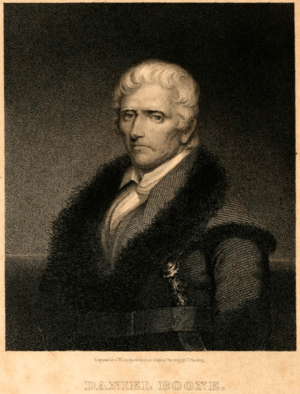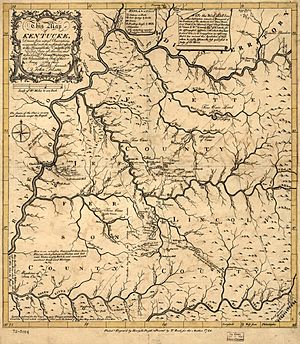The Discovery, Settlement and Present State of Kentucke facts for kids

The Discovery, Settlement and Present State of Kentucke is a famous book from 1784. It was written by John Filson. The book tells the story of how Kentucky was explored and settled. It also describes how land was bought there. Some parts of the book might not be totally accurate.
The book has a big extra section called an appendix. This part includes exciting stories about Daniel Boone. These stories are told as if Boone himself was speaking. The appendix also briefly describes a meeting with the Piankashaw Native American tribe. It then talks about other tribes living near Kentucky.
Contents
About the Author and Book

John Filson was a teacher, historian, and land surveyor. He wrote The Discovery, Settlement and Present State of Kentucke in 1784. Filson lived in Lexington, Kentucky. His book is seen as the first history of Kentucky ever written.
The book also includes the very first map of Kentucky. Filson gave this map to the United States Congress and George Washington. Filson's book helped make Daniel Boone famous. Boone was a frontiersman, meaning he explored new lands. He also helped found Boonesborough, Kentucky. Boone was a military officer during the American Revolutionary War. He also worked as a merchant and a surveyor.
What the Book Is About
Filson's book says that James M. Bride and others first found Kentucky in 1754. They marked their discovery on a tree. This tree was located at the mouth of the Kentucky River.
In 1769, Daniel Boone and John Finley decided to go back to Kentucky. They wanted to explore it more. Boone was the only one who survived attacks from local Native American tribes. He stayed in the Kentucky wilderness until 1771.
Filson writes that the land north of the Kentucky River was bought from the Five Nations. The land south of the river was bought in 1775. This happened during a treaty with the Cherokee Indians at Wataga.
Filson also explains three ways people could get land in Kentucky:
- First, soldiers could get land. This was a reward for their service in past wars.
- Second, people who lived in the area for over a year could get land. They also got land if they grew a crop of corn. They received four hundred acres.
- Third, people who built a cabin or made improvements to the land could also get it.
Daniel Boone's Adventures
The appendix of Filson's book shares true stories of Daniel Boone. It tells about his adventures and explorations in Kentucky. These events happened during the American Revolution. Boone first explored Kentucky in 1769. He was with John Finley, John Steward, Joseph Holden, James Monay, and William Cool.
Native Americans in the area often attacked Boone and his men. This caused many problems during their travels. Despite the battles, Filson describes Boone as a very positive person. Boone believed his stories would show others how amazing Kentucky was. He said Kentucky would become "one of the most opulent and powerful states" in North America. He felt the love of his countrymen was a great reward for his hard work.
Native American Culture and Kentucky's Future
Filson's book also talks about the differences between American religion and Native American beliefs. He notes that Native Americans seemed to know about a higher power. However, they did not worship in the same way. Roman Catholicism was introduced to some Native Americans near Detroit.
Filson describes how Native Americans celebrated good fortune with festivals. He also writes about their worship, marriage traditions, and gender roles. He mentions how they treated captives.
Filson ends the appendix by talking about Kentucky's future. He believed the people of Kentucky would be very happy. This was because the country was so large and fertile. He highlighted four important natural qualities for a country's success: good soil, air, water, and trade.

